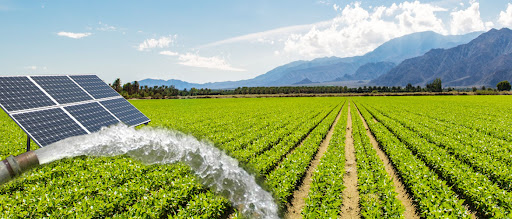A Solar-Agricultural Project for Clean Energy and Farming
The government has finally implemented a great idea. Germany, a country recognized for its leadership in technology and commitment to excellence, leads the SUNfarming project. This innovative initiative, The Solar-Agricultural Project for Clean Energy and Farming, aims to blend solar energy production through the installation of photovoltaic panels with farming activities taking place underneath. The project promises significant benefits for our island.
Additionally, the project employs photovoltaic panels as shelters from weather conditions while allowing light penetration. This dual-purpose solution offers “sheltered farming” and clean, renewable energy production within a single budget, reducing pollution and fuel imports.

Advantages of Integration:
SUNfarming Africa, part of the German SUNfarming Group, designed a 5,000 m2 system in Gros-Cailloux. The Mauritius Renewable Energy Authority approved this solar-agricultural project under the National Scheme for Emerging/Innovative Renewable Energy Technologies (NSEIRET). With support from the German Ministry of Economy and Climate, it will produce 200 kWp of electricity. Germany’s integration of climate with the economy ministry underscores its commitment to sustainable development.
Following the inauguration and Lesjongard’s speech, journalists asked about accusations by Patrick Assirvaden regarding CEB mismanagement. Lesjongard avoided these accusations, criticizing the MP and Labour Party’s renewable energy misunderstanding. He contrasted SUNfarming with the unsuccessful City Power project. Assirvaden also criticized CEB’s deficits.
City Power vs. SUNfarming
After the project’s inauguration, journalists questioned Joe Lesjongard about accusations by Patrick Assirvaden regarding CEB mismanagement. Lesjongard deflected these accusations, criticizing the MP and Labour Party’s renewable energy understanding. He contrasted SUNfarming with the unsuccessful City Power project. Assirvaden also criticized CEB’s deficits.
He also accused Lesjongard of dismantling everything Ivan Collendavelloo had started, like the project to cool buildings in Port Louis with seawater, now switching to a project to burn “fataks” and wood chips for energy. Actually, Maneesh Gobin prepared the biomass project. Regarding the “fatak,” Assirvaden’s colleague, Fabrice David, defended it vigorously. Luckily, David was not invited to this inauguration happening in his constituency.

Past Projects and Criticisms:
On February 7, 2019, Ivan Collendavelloo, the former Energy Minister, unveiled a 16.34 MW photovoltaic farm in Solitude spread over 20 hectares (equivalent to 28 football fields). Unlike SUNfarming, the panels were set close to ground level, about 1 meter high, making the land unsuitable for agriculture or other uses.
When Collendavelloo later suggested raising the panels for greenhouse farming, a journalist asked why it wasn’t done at the start, incurring future costs and making the land unusable. Collendavelloo then refused to speak to the journalist’s media outlet, asking for a “more serious” one. Four years later, the new minister and the Environment Minister have installed elevated panels for both electricity generation and greenhouse farming. This change comes after the St-Louis energy scandal, which contributed to Collendavelloo’s removal.
Source: https://lexpress.mu/node/426379


